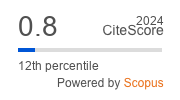Comparison of sensor activity in carbon nanotubes modified with functional groups
https://doi.org/10.17073/1609-3577-2016-3-204-209
Abstract
This article presents a theoretical study of sensor activity of nanosystems based on carbon nanotubes modified with functional groups (carboxyl, aminogen, nitrogroup) for some metal atoms and ions. Calculations have been performed within the frameworks of a molecular cluster model with the use of the semiempirical MNDO method and the density functional theory DFT. The mechanism of functional group binding to the open border of single−walled zig− zag carbon nanotubes leading to the formation of chemically active sensors on their basis has been investigated. Main geometric and electron energy characteristics of the resultant systems have been defined. Interaction of the sensors so synthesized with atoms and ions of some metals, e.g. potassium, sodium and lithium, has been analyzed.
About the Authors
N. P. BorozninaRussian Federation
Natalya P. Boroznina — Cand. Sci. (Phys.−Math.), Associated Professor.100 Universitetskii Prospekt, Volgograd 400062.
I. V. Zaporotskova
Russian Federation
Irina V. Zaporotskova — Dr. Sci. (Phys.−Math.), Professor, Director of the Institute of Priority Technologies.
100 Universitetskii Prospekt, Volgograd 400062.
References
1. Dyachkov P. N. Elektronnye svoistva i primenenie nanotrubok [Electronic properties and application of carbon nanotubes]. Moscow: BINOM, 2014. 488 p. (In Russ.)
2. Zaporotskaya I. V. Nanotube−based materials: structure, properties and applications. Nanotekhnika = Nanotechnics. 2005, no. 4, pp. 42—54. (In Russ.)
3. Eletskii A. V. Sorption properties of carbon nanostructures. Physics−Uspekhi, 2004, vol. 47, no. 11, pp. 1119—1154. DOI: 10.1070/PU2004v047n11ABEH002017
4. Akhmadishina K. F., Bobrinetskii I. I., Komarov I. A., Malovichko A. M., Nevolin V. K., Petukhov V. A., Golovin A. V., Zalevskii A. O. Flexible biological sensors based on carbon nanotube films. Nanotechnologies in Russia, 2013, vol. 8, no. 11–12, pp. 721—726. DOI: 10.1134/S1995078013060025
5. Gengzhi Sun, Shiwei Liu, Kaifeng Hua, Xiangyu Lv, Li Huang, Yujiang Wang. Electrochemical chlorine sensor with multi−walled carbon nanotubes as electrocatalysts. Electrochemistry Communications, 2007. vol. 9, no. 9, pp. 2436—2440. DOI: 10.1016/j.elecom.2007.07.015
6. Piloto C., Mirri F., Bengio E. A., Notarianni M., Gupta B., Shafiei M., Pasquali M., Motta N. Room temperature gas sensing properties of ultrathin carbon nanotube films by surfactant−free dip coating. Sensors and Actuators B: Chemical, 2016, vol. 227, pp. 128— 134. DOI: 10.1016/j.snb.2015.12.051
7. Chopra S., Pham A., Gaillard J., Parker A., Rao A. M. Carbon− nanotube−based resonant−circuit sensor for ammonia. Appl. Phys. Lett., 2002, vol. 80, no. 24, pp. 4632—4634. DOI: 10.1063/1.1486481
8. Ghosh S., Sood A. K., Kumar N. Carbon nanotube flow sensors. Science, 2003, vol. 299, no. 5609, pp. 1042—1044. DOI: 10.1126/science.1079080
9. Kim S. N., Rusling J. F., Papadimitraopoulos F. Carbon nanotubes for electronic and electrochemical detection of biomolecules. Adv. Mater., 2007, vol. 19, no. 20, pp. 3214—3228. DOI: 10.1002/adma.200700665
10. Cao Q., Rogers J. A. Ultrathin films of single−walled carbon nanotubes for electronics and sensors: a review of fundamental and applied aspects. Adv. Mater., 2009, vol. 21, no. 1, pp. 29—53. DOI: 10.1002/adma.200801995
11. Hao−Lin Hsu, Jih−Mirn Jehng, Yuh Sung, Li−Chun Wang, Sang−Ren Yang. The synthesis, characterization of oxidized multi− walled carbon nanotubes, and application to surface acoustic wave quartz crystal gas sensor. Mater. Chem. Phys., 2008, vol. 109, no. 1. pp. 148—155. DOI: 10.1016/j.matchemphys.2007.11.006
12. Wong S. S., Josevlevich E., Wooley A. T., Cheung C. L., Lieber C. M. Covalently functionalized nanotubes as nanometer−sized probes in chemistry and biology. Nature. 1998, vol. 394, pp. 52—55. DOI: 10.1038/27873
13. Thu Hong Tran, Jin−Woo Lee, Kyongsoo Lee, Yang Doo Lee, Byeong−Kwon Ju. The gas sensing properties of single−walled carbon nanotubes deposited on an aminosilane monolayer. Sensors and Actuators B: Chemical, 2008, vol. 129, no. 1. pp. 67—71. DOI: 10.1016/j.snb.2007.07.104
14. Zaporotskova I. V., Polikarpova N. P., Vil’keeva D. E. Sensor activity of carbon nanotubes with a boundary functional group. Nanoscience and Nanotechnology Lett., 2013, vol. 5, no. 11, pр. 1169—1173. DOI: 10.1166/nnl.2013.1704
15. Polikarpova N. P., Zaporotskova I. V., Boroznin S. V., Zaporotskov P. A. About using carbon nanotubes with amino group modification as sensors. J. Nano− Electron. Phys., 2015, vol. 7, no. 4, pр. 04089–1—04089–3. URL: http://essuir.sumdu.edu.ua/handle/123456789/44562
16. Dewar M. J. S., Thiel W. Ground states of molecules. 38. The MNDO method. Approximations and parameters. J. Amer. Chem. Soc., 1977, vol. 99, no. 15, pp. 4899—4907. DOI: 10.1021/ja00457a004
17. Dewar M. J. S., Thiel W. A semiempirical model for the two−center repulsion integrals in the NDDO approximation. Theoret. Chem. Acta, 1977, vol. 46, no. 2, pp. 89—104. DOI: 10.1007/BF00548085
18. Kohn W. Nobel lecture: Electronic structure of matter−wave functions and density functionals. Rev. Mod. Phys., 1999, vol. 71, no. 5, pp. 1253—1266. DOI: 10.1103/RevModPhys.71.1253
19. Burke K., Werschnik J., Gross E. K. U. Time−dependent density functional theory: past, present, and future. J. Chem. Phys., 2005, vol. 123, no. 6, pp. 062206—062214. DOI: 10.1063/1.1904586
20. Jones R. O., Gunnarsson O. The density functional formalism, its applications and prospects. Rev. Mod. Phys., 1989, vol. 61, no. 3, pp. 689—746. DOI: 10.1103/RevModPhys.61.689
Review
For citations:
Boroznina N.P., Zaporotskova I.V. Comparison of sensor activity in carbon nanotubes modified with functional groups. Izvestiya Vysshikh Uchebnykh Zavedenii. Materialy Elektronnoi Tekhniki = Materials of Electronics Engineering. 2016;19(3):204-209. (In Russ.) https://doi.org/10.17073/1609-3577-2016-3-204-209





































